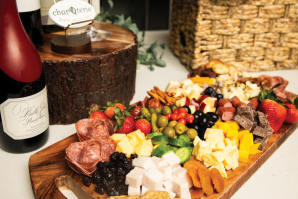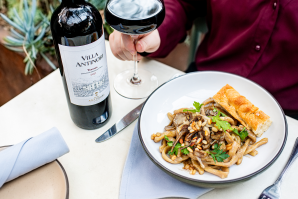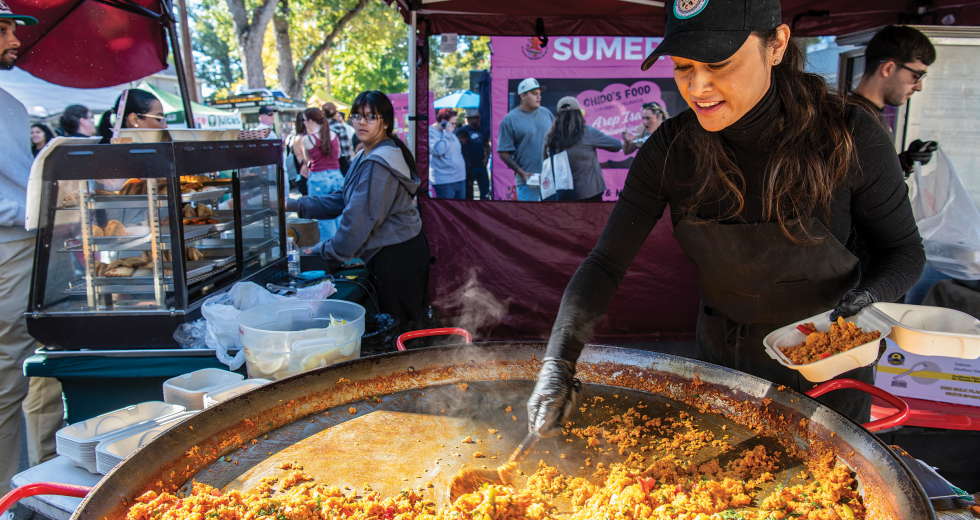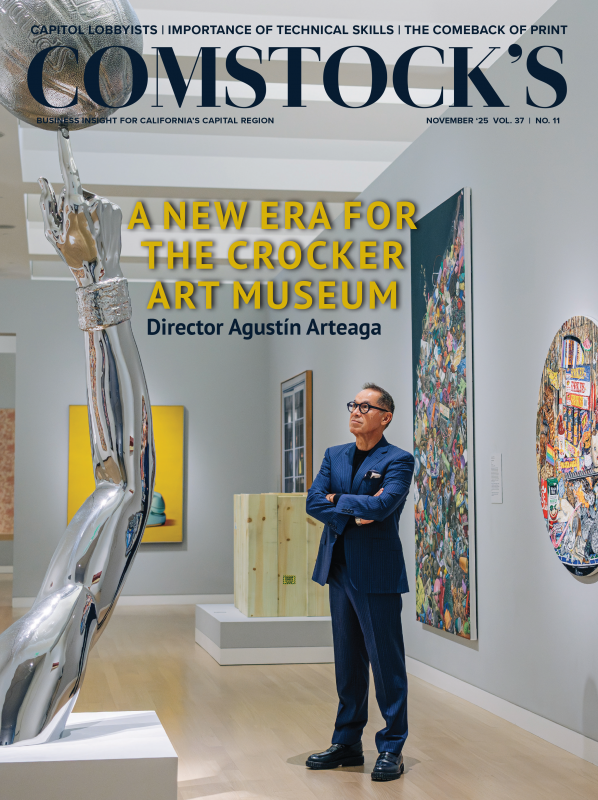The largest pan Maria Perez owns is 8 feet, and she says that, armed with several of those, she can cook paella for 3,000 guests. Perez debuted her “California-friendly” paella at Sacramento’s Midtown Farmers Market in May 2021, inspired by a trip to Spain. In August of this year, she opened her Midtown storefront, Maria’s Empanadas and Paella. But she still prepares her signature dish every Saturday at the market, sauteing aromatics, chicken, shrimp, rice and broth in three 6-foot pans. Typically, the Spanish use short-grain bomba rice, but Perez uses Calrose, which absorbs the deep, smoky flavors of the paprika, garlic, saffron and other spices that give her paella its depth.
What is paella, and why is it so beloved worldwide? This iconic rice dish evokes unity, togetherness and family for many Spanish people. In 2021, the Valencia government granted it protected status to preserve its cultural significance and authenticity for future generations. According to that designation, paella Valenciana is a strictly defined dish, containing no seafood and certainly no chorizo — the primary proteins being rabbit, chicken, duck, snails and beans.
In the Capital Region, however, the paella that restaurants serve can be as diverse as the community that surrounds them. The four paella entrepreneurs Comstock’s spoke with said they broke with tradition to accommodate local preferences and dietary restrictions, but they still employ traditional techniques to maintain authentic flavors.
Humble beginnings
Perez describes her paella as Californian. She says the flavors are there, but her version doesn’t have as much socarrat — a caramelized crust that adds texture and taste — as those found in Spain. She prefers this, because paella with a lot of socarrat can be perceived as dry. Business improved after she introduced Mexican-style empanadas to her paella stand, with fillings such as chicken mole and chicharrón.
Before that, she was trying to find her purpose. When Perez’ older brother died from COVID in July 2021, she asked herself if she was on the right path. As a single mother, Perez worked in real estate and did loans, but that wasn’t it, she says.
Perez remembers a trip to London in 2019 with her good friend, when she heard someone yell, “Paella!” She stood in line, got her plate and dined at a communal table with people from Italy, Morocco and Mexico. Perez recalls telling her friend how much she loved the energy paella brings. “One day I will be selling paella in a market in Sacramento,” Perez says. “And I remember we cheered to that.” Little did Perez know she would act on her inspiration.
With her restaurant, Perez aims to offer affordable, quick, tasty and healthy meals. “I didn’t want to wait until Saturday to have my products available,” Perez says. “I want to have it all day. … I want to create these grab-and-go beautiful trays for families.” She explains when people get off work, she can have their order ready to take home and reheat.
Party with a pan
Stan Halverson, owner and chef of Yay! Paella Catering in Folsom and Santa Rosa, also adds a California twist to paella by adding garbanzo beans to his multi-layered dish. Halverson’s most popular offering is paella mixta, which contains chicken, seafood and chorizo. “If you find a purist, they will say they don’t put that (garbanzo beans) over there in Spain,” he says. “But people want that flavor.”
Halverson says he doesn’t go too “crazy” with varieties, but does offer a black squid ink paella, which “are always the first ones gone” at parties. His shrimp skewer tapa with smoked paprika, imported from Spain, is another client favorite.
Halverson worked for Napa’s Gerard Nebesky, who beat Bobby Flay in a televised paella throwdown in 2008, from 2008 to 2016, cooking at festivals such as Coachella and BottleRock Napa Valley, serving 2,000 plates a day. The entrepreneur branched out on his own in 2016 in the Santa Rosa area. In 2018, Halverson and his wife moved to Sacramento because they were coming up this way frequently to meet with friends and family, and wanted to start a “wing” here.
Halverson says catering his own son’s wedding at Taber Ranch near Woodland was one of his most difficult assignments. “Our son did get married in 2019 outside of Woodland at Taber Ranch,” he says. “That was very hard to put my chef clothes on, then put my suit back on, and then after the ceremony, run down, put my chef clothes back on, serve everybody, and then put my suit back on to go dancing. Oh my gosh, I won’t do that again. I’ve only got two more kids to get married, so.”
Seize the paella
Paul Grant helps his wife, Addy Grant, prepare paella for an
event at Bokisch Vineyards in Lodi.

Before Grant left Spain, she brought back a pan, rice and spices. Her husband loved her paella, and when Grant’s brother went to visit their sister in Spain six months later, Grant’s husband told her, “You need a bigger pan,” Grant says.
Grant recalls her sister calling her up, “laughing hysterically,” how her brother had a hard time getting the 3-foot pan into the taxi and had to tie it to the roof. Her brother carried it through customs in New York, and people thought he was a celebrity, with some thinking it might be a toboggan, Grant says.
One day, unexpectedly, in 2011, the Lodi Winegrape Commission called. “They said, ‘Hey, we hear you cook this paella. We’ve got Zinfest coming up. Would you consider cooking paella out at Zinfest?’ So then, my husband sat down and decided, like, ‘Is this going to be a business?’ And we thought, ‘let’s go for it.’” That was May, and in November, they won Berryessa Gap Vineyard’s annual paella competition, taking first place.
Grant says her paella isn’t traditional; it’s her “take” on it. She omits tomatoes because of her family’s preference. During Halloween, a favorite is black squid ink paella with calamari. “We put the tentacles in it so it looks like creatures coming out of the rice,” Grant says. She also offers guests homemade garlic aioli to drizzle over their paella. When there are leftovers, Grant eats them for breakfast and adds a fried egg on top.
Tried and true
Although born in Nicaragua, Chef Jennifer Romero traced her lineage to Málaga, Spain, where her paternal great-grandfather used to make paella for her grandfather, who, in turn, passed that tradition down.
Jennifer Romero, owner of the catering business Hooked on Paella,
made this paella in her backyard.

Romero describes her style as Valencian and strives to adhere as closely as possible to the traditional recipe, but she doesn’t include snails and rabbits because she says they make people feel “sad.” Romero elaborates how she has “perfected her craft” by watching the legendary Valencian chef Toni Montoliu’s process and by engaging with him during a tour of the area surrounding his barraca, a “traditional small farm-like structure,” on a horse-drawn wagon. During this experience, Romero asked about vegan paella.
“‘There is no such thing as vegan paella,’” Romero says Montoliu told her. “And I said, ‘But there is in California.’ I said I live in California, so I have to offer that. So he said, ‘If you must do it, just use fresh vegetables and never canned anything.’” Romero says nowadays, in some parts of Spain, there are vegan paellas to accommodate tourists.
But paella is not just about the ingredients; it’s about the interaction, energy and the whole experience it brings. As Perez of Maria’s Paella and Empanadas says, “This business, it’s very community oriented; made by the community, between my neighbors, my customers at the market and me cooking for them. So it’s a little circle that never ends. They’re helping me, I’m helping them, and that’s how we are going ahead together.”
–
Stay up to date on business in the Capital Region: Subscribe to the Comstock’s newsletter today.
Recommended For You

Step Inside Sacramento’s Most Immersive Tiki Worlds
Bars like Shipwrecked and Hawthorne’s Hideout fuse fantasy, craftsmanship and cocktails for total escapism
The first sight through the door is something like an aquatic gargoyle with long fingers, smiling fangs and the scaly tail of a mercreature from the lowest depths.

The Capital Region’s Charcuterie Entrepreneurs Are Turning Grazing into a Gourmet Experience
Charcuterie boards gained national attention from the business crowd in 2022, when Aaron Menitoff and Rachel Solomon Fascitelli, co-founders and co-CEOs of the online cheese and charcuterie gifting business Boarderie, appeared on “Shark Tank,” eventually walking away with a deal from Lori Greiner and generating $70 million in revenue.

Chefs, Growers and Citizen Scientists Are Embracing Mushroom Foraging and Its Culinary Potential
The farm-to-fork pipeline is well established in Sacramento — but what about forage-to-fork? We talked to some of the foragers, scientists, chefs and enthusiasts who want to see more foraging in the Capital Region.

Omakase Reimagined
The Japanese tasting menu concept is branching out to other cuisines
Omakase has evolved from a Japanese culinary tradition mostly associated with high-end sushi restaurants to a dining concept that accommodates a wide range of palates.




